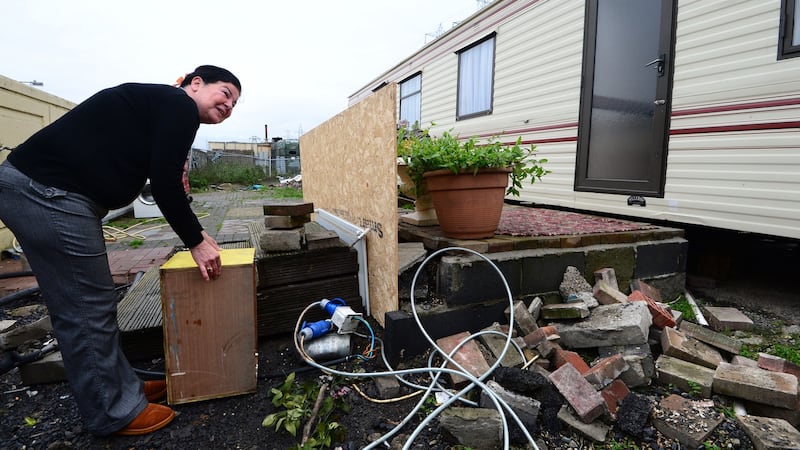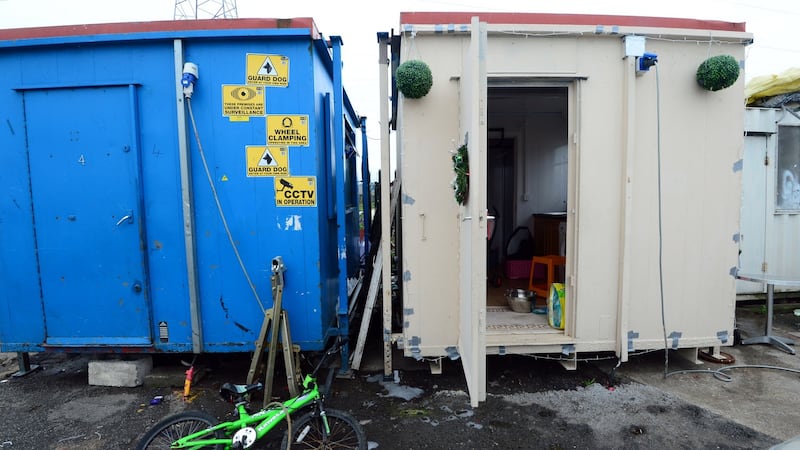Sally-Anne Berry (24) has been “very afraid” for the safety of her young family since the night of January 29th last.
This was when a fire broke out in an outhouse about three metres from their caravan, at the Labre Park Traveller housing site in Dublin.
“It was about 10pm . . . A neighbour parked up outside, [and] said he saw smoke coming from the unit.


“We ran out of our trailer and all of us, the neighbours, we put it out with water,” she recalls.
“Only the fact it was not late – people were awake – it could have spread easily to other caravans. After what happened in Carrickmines, you would be very afraid about a fire here.”
They share a yard with seven other families, including 23 children.
The space should accommodate two families. Each family has a "sanitation unit" provided by Dublin City Council, which crowds the space.
Sally-Anne, originally from Bray, married Tommy Berry five years ago. They live in a small caravan with their daughters Savannah (3) and Kate-Lynn (three months).
Department of Environment fire-safety guidelines state six metres should separate caravans in residential parks. Less than a metre separates some vans here.
There are no dividing screen walls between the vans or between vans and units – another stipulation.
Electric wires trail over broken and uneven tarmac. After rain, there are pools of water everywhere.
“We’re all on top of each other here and there’s nowhere safe to let children out,” says Sally-Anne.
Similarly hazardous and overcrowded “yards” can be seen further down the site.
In all, there are 24 families, including 54 children under 12 years old, in caravans. There are also 19 families in houses onsite.
Anne Connors shows exposed electricity mains outside the mobile home in which she has lived for 10 years.
A wooden box was provided to protect the mains.
“It’s just held there with blocks. It’s not safe. I like it here, like living here. I know everyone but it’s the conditions are the heartbreak.”
Labre Park is the oldest purpose-built Traveller accommodation site in the State.
Constructed in 1967, it provided accommodation to 28 families then living in squalid conditions in Cherry Orchard fields.
It was intended as a housing scheme but families have expanded and moved caravans to the 4½-acre site.
There are more families in caravans than houses. Residents said they liked living “with our community” but felt isolated in the wider area. Conditions are “not very nice” and “very hard”.
The council says none of the caravans is “authorised” but some have been there for more than 20 years.
"Unfortunately, as unauthorised caravans arrive they park very close to existing unauthorised caravans," said a spokeswoman, adding it was working with Ballyfermot Travellers Action Project to facilitate movement of caravans to other locations on the site.
Redevelopment plans
Plans to redevelop Labre Park have been included in all Dublin City Council’s Traveller Accommodation Programmes (TAP) since 2000.
More recently, the 2005-2008 programme outlined plans for 11 houses and 11 bays, which would “resolve the present accommodation needs”. They were not built.
The 2009-2013 programme said its “new build” programme would include “22 units” for Labre Park.
The current 2014- 2018 TAP, says: “Unfortunately, a serious downturn in the economy resulted in several of the bigger housing schemes which contained Traveller accommodation units not going ahead.”
However, it describes an innovative plan to work with Clúid, a voluntary housing organisation, to redevelop Labre Park.
Drawn up by Walsh Associates Architects, in consultation with residents, the plan describes Labre Park as a "densely populated area . . . where mobile homes are located in close proximity to each other in difficult conditions which give rise to many concerns, not least of which is means of escape in the case of fire."
It proposes building 31 houses, as well as a central communal area, a playground, a ball court, as well as a community and office facility. Clúid would take over day-to-day management from Dublin City Council.
In April, the council submitted the Clúid plan to the Department of the Environment for funding under the capital assistance scheme, which would have provided 100 per cent of the estimated €5 million cost. It was turned down in July.
Clúid is assessing whether the plan can be funded under the capital advance leasing facility, which would see it get up to 30 per cent funding, the balance to be raised privately.
Sally-Anne would love to “have all the facilities in around you, you wouldn’t have to go out with the children in the cold at night.
“I do hope the plans work, not just for my kids, but for all the kids on the site. It’s not safe for them and it’s not right that they’re living like this.”














